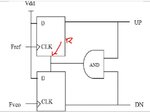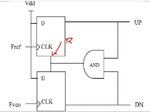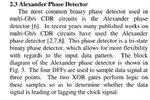yefj
Advanced Member level 4
adding reset function to D Flip FLOP for phase detector
Hello, I have designed a rising edge D-flipflop as shown bellow using CML method.
I could have just connect the output to NMOS switch and discharge it to ground.
However in our reset signal comes at Q, so basickly if we have Q=1 then this Q=1 is used to turn Q into Q=0.
so we have oscilation.
How do i add "reset" to my D-flip flop So i could use it in phase detector as shown bellow?
Thanks.



Hello, I have designed a rising edge D-flipflop as shown bellow using CML method.
I could have just connect the output to NMOS switch and discharge it to ground.
However in our reset signal comes at Q, so basickly if we have Q=1 then this Q=1 is used to turn Q into Q=0.
so we have oscilation.
How do i add "reset" to my D-flip flop So i could use it in phase detector as shown bellow?
Thanks.


Last edited:






